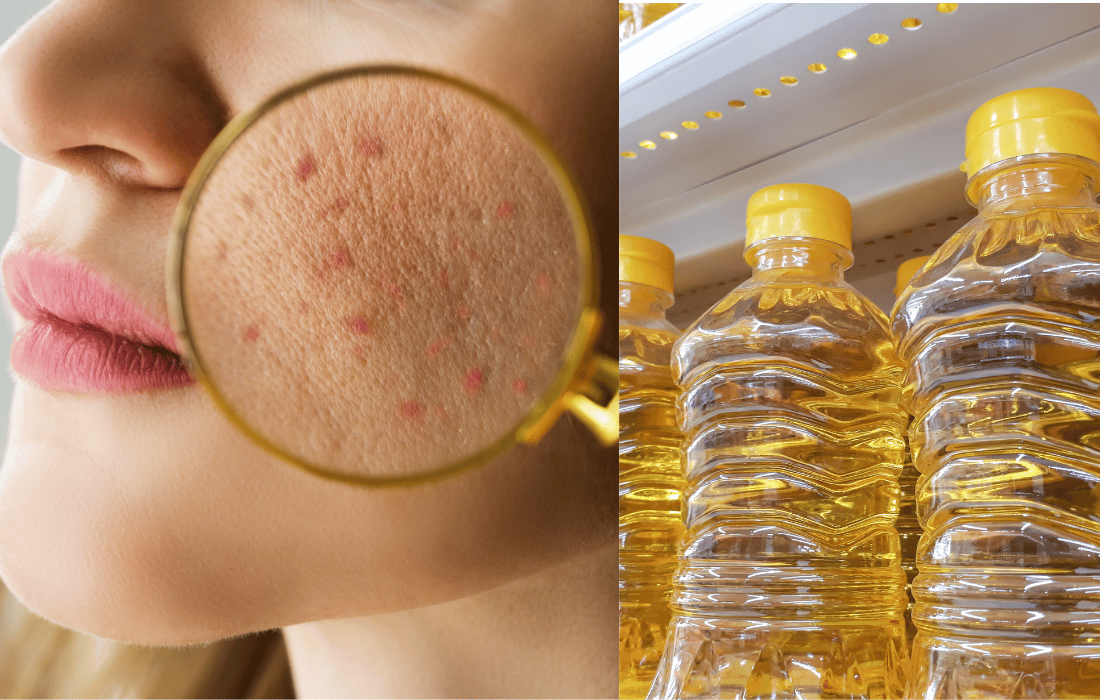Our skin acts as a mirror, reflecting what’s happening internally. With today’s diets overwhelmingly rich in omega-6 and fatty acids due to the rise of seed oils like soybean, corn, and sunflower oils, people are experiencing heightened rates of skin conditions. While these oils are often marketed as “heart-healthy,” mounting evidence suggests they may contribute to inflammation, acne, premature aging, and even more severe skin issues. Let’s explore how seed oils impact skin health and the steps you can take to promote clear, resilient skin.
The Omega-6 to Omega-3 Ratio: A Historic Shift and Why It Matters
Traditional diets typically maintained a 1:1 balance of omega-6 to omega-3 fatty acids. This balance played a critical role in keeping inflammation low and maintaining skin health. Today, however, the average diet includes a 15:1 or even 20:1 ratio, tipping the scales toward omega-6 and, consequently, inflammation.
This shift stems largely from the widespread use of seed oils in processed foods, restaurants, and home cooking. Seed oils are high in omega-6 fatty acids, which, while essential in small amounts, promote inflammation when consumed in excess. Research in 2012 underscored how a skewed omega-6 to omega-3 ratio impacts cellular processes, contributing to chronic inflammation and skin issues.
The Role of Omega-6 in Inflammatory Skin Conditions: Acne, Eczema, and Beyond
Acne and Omega-6
Acne isn’t solely a cosmetic issue—it’s an inflammatory skin condition, and diet plays a major role in its development. Research indicates that omega-6 fatty acids exacerbate inflammation in skin cells, which can clog pores, attract acne-causing bacteria, and lead to breakouts.
Sebum Production and Oxidation: Omega-6 fats, especially linoleic acid, oxidize quickly, particularly when exposed to heat. Oxidized linoleic acid alters sebum consistency, making it more prone to clogging pores. Studies clearly prove that adults with a high omega-6 to omega-3 ratio experienced significantly higher acne severity than those with a balanced ratio.
Hormonal Influence on Skin: Omega-6 intake may also influence hormone levels, including androgens, which increase sebum production. This hormonal impact is why high omega-6 intake can worsen acne, especially during periods of hormonal shifts, like adolescence or stressful periods.
Eczema and Skin Barrier Dysfunction
Eczema is an inflammatory skin condition characterized by itchy, red, and often cracked skin. Omega-6 fatty acids can exacerbate eczema by increasing inflammatory compounds in the body. For individuals with eczema, omega-6 fats disrupt the skin’s lipid barrier, leading to moisture loss and increased vulnerability to irritants.
A 2024 study demonstrated that individuals with eczema who reduced their omega-6 intake and increased their omega-3 consumption experienced fewer flare-ups and an overall reduction in symptoms. The anti-inflammatory properties of omega-3s strengthen the skin barrier, helping it retain moisture and better resist irritants.
Oxidative Stress and Premature Aging: How Seed Oils Accelerate Skin Aging
One of the most concerning impacts of omega-6 on skin health is its role in oxidative stress. Oxidative stress is a process where free radicals damage skin cells, accelerating the aging process. Consuming seed oils high in omega-6 leads to an increase in reactive oxygen species (ROS) in the body, which breaks down collagen and elastin, the proteins that keep skin firm and youthful.
The Link Between Oxidative Stress and Collagen Breakdown
Collagen breakdown is a key factor in skin aging, resulting in wrinkles, sagging, and loss of elasticity. Omega-6 fatty acids produce pro-inflammatory byproducts like malondialdehyde when they break down, damaging collagen structures. Over time, this damage accumulates, leading to visible signs of aging.
- UV Radiation and Seed Oils: Overexposure to the sun contributes to oxidative stress, but omega-6 fats can worsen this effect. The oxidation of omega-6 fatty acids under UV radiation generates toxic aldehydes, accelerating skin aging. Studies show that diets high in omega-6 increase susceptibility to UV damage and lead to collagen breakdown.
Cellular Aging and Free Radical Damage
Free radicals attack cells, altering their structure and function. In the skin, this leads to the visible signs of aging, including fine lines, hyperpigmentation, and loss of elasticity. Limiting omega-6 intake can reduce oxidative stress and support healthier, more resilient skin.
Seed Oils and Skin Cancer: A Potential Connection
While UV radiation is a well-known risk factor for skin cancer, emerging research suggests that dietary linoleic acid from seed oils could also play a role. Linoleic acid, the primary omega-6 fatty acid in seed oils, has been shown to degrade into pro-inflammatory byproducts when exposed to UV light, increasing skin cancer risk.
Between 1950 and 2007, melanoma rates increased dramatically, even as people used more sunscreen and spent more time indoors. One hypothesis is that the rise in omega-6 fatty acid consumption is a major contributing factor. Studies have found that increasing dietary linoleic acid corresponded with higher melanoma incidence, suggesting that omega-6 fats may exacerbate sun-induced DNA damage and contribute to cancer formation.
The Hidden Omega-6 in Processed Foods
Beyond cooking oils, seed oils lurk in countless processed foods, making it challenging to maintain a balanced omega ratio. Foods such as crackers, chips, salad dressings, and even some “healthy” granola bars are loaded with these oils.
Here are common sources of hidden omega-6:
- Snacks and Baked Goods: Chips, crackers, cookies, and pastries frequently contain oils like soybean and cottonseed.
- Dressings and Condiments: Many store-bought salad dressings and sauces contain sunflower or canola oil as a primary ingredient.
- Restaurant Foods: Restaurants often use inexpensive, omega-6-rich oils for frying and sautéing, making it difficult to avoid these fats when dining out.
Reading labels can be an effective first step in reducing hidden omega-6 from your diet. However, cooking at home with omega-6-free oils is the most reliable way to limit intake.
Skin-Friendly Fat Alternatives: Oils That Support Skin Health
Transitioning to healthier fats can profoundly impact skin health. Here are some beneficial alternatives to omega-6-rich seed oils:
Animal Fats: Tallow and Butter
Animal fats like tallow and butter contain fat-soluble vitamins (A, D, E, K) essential for skin health. These fats are naturally low in omega-6 and are highly stable, making them ideal for cooking.
Butter and Ghee
Grass-fed butter and ghee (clarified butter) are both rich in stable, saturated fats and fat-soluble vitamins like A, D, E, and K, which are essential for skin health. These fats are low in omega-6 and ideal for high-heat cooking. Ghee, especially, has a higher smoke point, making it suitable for sautéing and frying while still offering rich nutrients for the skin.
Coconut Oil
Coconut oil, a saturated fat, is less prone to oxidation and provides natural antimicrobial properties. It’s also a source of medium-chain triglycerides (MCTs), which can improve skin hydration.
Olive Oil
Extra virgin olive oil is a rich source of antioxidants and monounsaturated fats that protect against oxidative damage. Studies have shown that it supports a healthy skin barrier and improves elasticity.
Practical Steps to Reduce Omega-6 and Improve Skin Health
Achieving skin health through diet requires more than just avoiding seed oils. Here are actionable steps for supporting your skin from the inside out:
Increase Omega-3 Intake: Omega-3 fatty acids counteract the pro-inflammatory effects of omega-6. Incorporate foods like salmon, sardines, and chia seeds into your diet for a more balanced fat profile.
Prioritize Whole Foods: Processed foods are often laden with omega-6, so emphasizing whole foods can significantly reduce your intake.
Swap Cooking Oils: Use coconut oil, butter, and olive oil for cooking instead of omega-6-rich oils. These oils are not only healthier for your skin but are also stable at high temperatures, reducing oxidative stress.
Read Food Labels: Hidden seed oils are common in many packaged foods. Check labels to avoid unnecessary omega-6 intake.
Avoid Fried Foods When Dining Out: Many restaurants use omega-6-rich oils for frying, which contributes to the formation of free radicals. Opt for grilled, steamed, or baked options when eating out.
Request Butter or Bring Your Own: When dining out, let the restaurant know you have an allergy or sensitivity to seed and vegetable oils and request your food be cooked in butter or another suitable fat. Some places may even allow you to bring your own cooking fat, like butter or ghee, for added control over your omega-6 intake.
- Skin-Healthy Recipes: Incorporate recipes using fats that support skin health, such as roasted vegetables with avocado oil or stir-fried greens with coconut oil.
Debunking Common Myths Around Seed Oils
Myth #1: Seed Oils Are Heart-Healthy
Seed oils have been marketed as heart-healthy due to their polyunsaturated fat content. However, evidence suggests they contribute to coronary heart disease and chronic inflammation.
Myth #2: You Need Seed Oils for Essential Fatty Acids
While omega-6 is essential, a small amount found in whole foods like nuts and eggs is sufficient. Consuming it in excess from seed oils leads to inflammation and isn’t necessary for optimal health.
Myth #3: Cooking with Beef Tallow is Unsafe
Despite concerns about saturated fats, tallow is actually one of the most stable fats for cooking due to its high smoke point and resistance to oxidation. This stability makes it ideal for high-heat cooking, as it doesn’t break down into harmful compounds the way many seed oils do. Additionally, tallow is rich in fat-soluble vitamins like A, D, E, and K, which support skin health and cellular repair.
Conclusion: Nourishing Skin from the Inside Out
Clear, resilient skin requires more than topical treatments—it’s largely influenced by what we consume. Seed oils, though widely used, contribute to inflammation, oxidative stress, and accelerated aging, making them counterproductive to skin health. The good news? By replacing omega-6-rich seed oils with stable, skin-supportive fats like coconut oil, olive oil, and animal-based fats, you can support clearer, healthier skin.
Incorporating omega-3-rich foods, prioritizing whole foods, and choosing alternatives to processed seed oils can help reduce inflammation and foster long-term skin vitality. Our skin is a reflection of our inner health, and with these dietary adjustments, you can take control of your skin’s future.














